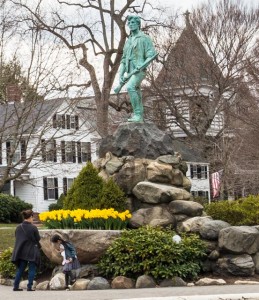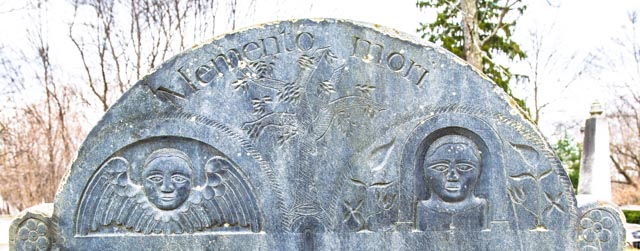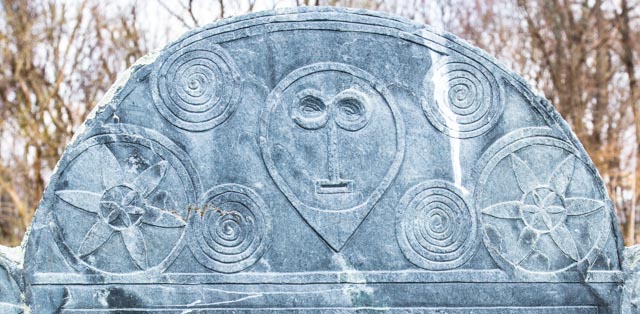
In eastern Massachusetts, it’s Patriots Day Weekend, the annual celebration of the ‘Shot Heard Round the World’, fired in Concord (the irony of its name goes unmentioned) on April 19, 1775.
***
Wednesday, I had a few minutes following lunch with a friend to amble in Lexington, just east of Concord along the Redcoats’ long line of retreat to Boston. I found The Old Burying Ground just off the Green behind the First Parish church.
By New England standards, its setting is unprepossessing and its grounds unkempt. Like so many graveyards dating to the 18th century and before, at some point its headstones were rationalised and alined. The east entrance is walled on one side with uprooted stones.
Still, this is a burying ground worth visiting. I found no one famous, but much fascinating.
***
The iconography on many of the 18th and early 19th century is so familiar I took it for granted. I won’t again.
For a period, evidently, of 50 years, between the early 1750s and early 1800s, gifted stone carvers supplied headstones that are remarkable in their decoration.

The joint headstone of Benjamin and Patiance Muzzy[1], who died, respectively, in 1764 and 1767 is in itself uncommon. Individual stones were the rule.
The winged head above Benjamin’s half is quite common. The head above Patiance’s half is unlike anything I’ve seen, except on the woman’s half of another joint stone a few yards away and a decade later. No wings, just finely carved flowers.
The tree that separates the halves is not the weeping willow which graces so many early 19th century stones but suggests it. Still, it seems more the tree of life leading to ‘Memento Mori’, ‘Remember that You Will Die’.
***
A few feet away are the remarkable headstones of a couple named Green. They died in the 1750s; the final digit on both stones is illegible.
 I can’t say the Greens’ headstones are unique, only that I’ve never seen anything like them. The stylised heads, as on Samuel Green’s, seem a thousand years older than they are – or two hundred years newer.
I can’t say the Greens’ headstones are unique, only that I’ve never seen anything like them. The stylised heads, as on Samuel Green’s, seem a thousand years older than they are – or two hundred years newer.
The four whirls surrounding the head look like the many Anglo-Saxon brooches in the crammed cases of the British Museum. They faces remind me of Anglo-Saxon helmets, the vertical line suggesting the nose, the horizontal box suggesting a mouth, the eyes deeply recessed. Nonetheless, the abstraction and the shape of the heads seem very 20th century.
I felt as if I were looking at something primal, something far more terrifying than winged heads. I didn’t need a ‘memento mori’.
***
Near the Old Burying Ground’s east entrance is a monument unlike any I’ve seen in Colonial graveyards. It memorialises the six children of Abijah and Sarah Childs who died in the course of eighteen days in 1778.

Abijah and Sarah lived on for twenty years, their nearby headstones say. How, any parent would wonder.
The smallpox epidemic of 1775-82 which swept North America affected and killed more than the war with which it coincided. And, it affected the Revolution’s outcome, as Elizabeth A. Feen writes in her excellent Pox Americana: the Great Smallpox Epidemic of 1775-82 (2001).
The Childs’s memorial made me aware of the disproportionate number of graves from those years.
***
A family named Harrington occupies a large part of the Old Burying Grounds’ northeast quarter.
One stone which seemed to have been slashed across its top quarter hinted at the willow and urn motif so common in New England in the 19th century’s first half. It remembers Lydia Harrington who died at 23 in 1803.
I remain uncertain quite what to make of the verse on the stone:
Death grasps all
No tears nor sighs nor prayers could save
The lovely Lydia from her early grave
Notes
1. Spelling as on headstone.
Recent Comments